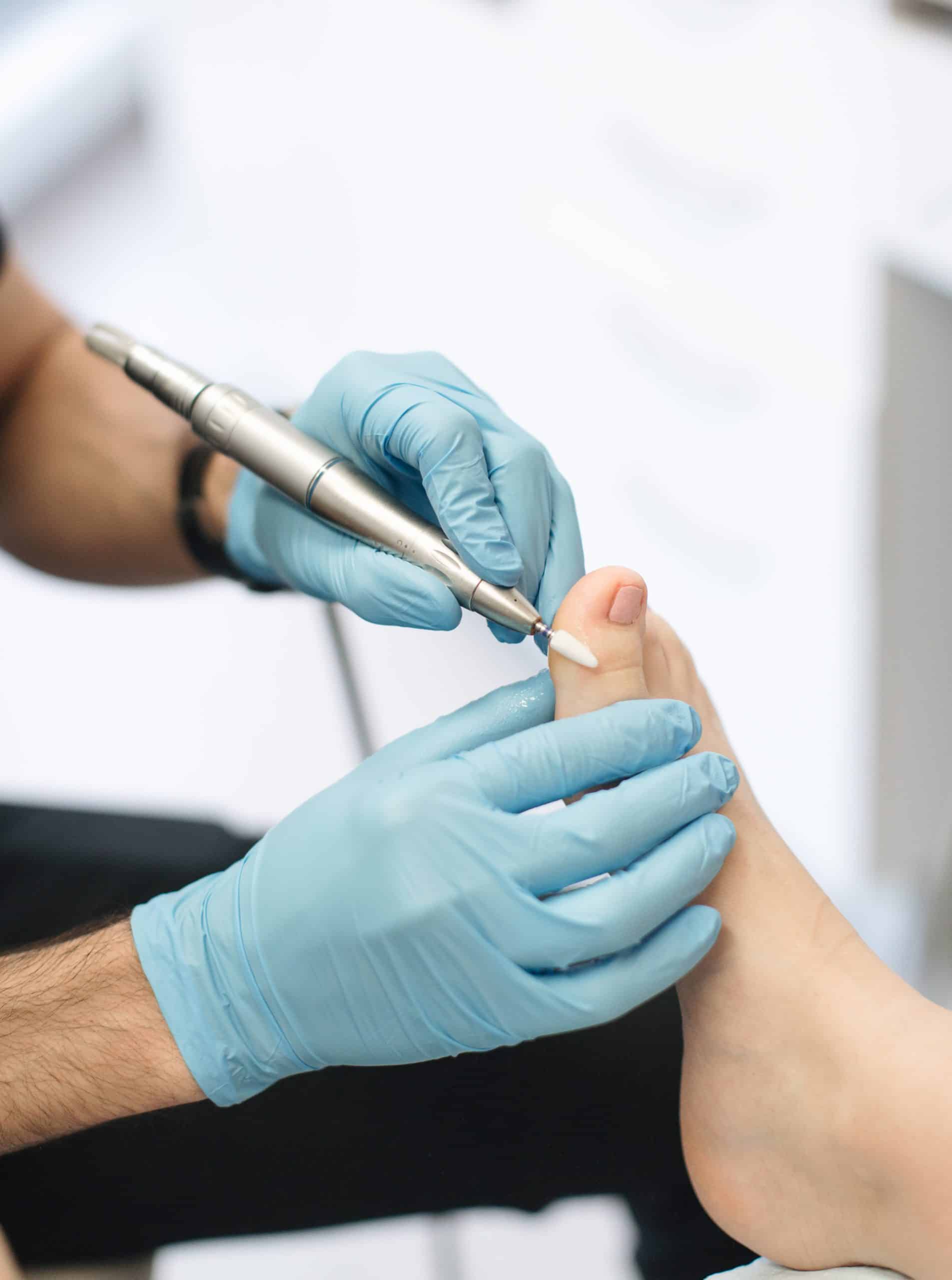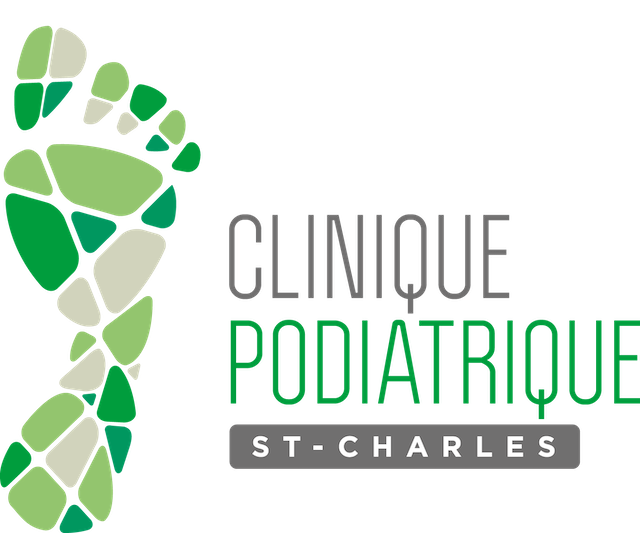Podiatric Treatments

PODIATRIC TREATMENTS AND CARE OFFERED AT THE CLINIC
We offer a wide range of podiatric treatments for the feet. Each case is unique and is evaluated individually and carefully.
Our range of treatments is chosen according to your condition.
Each of our podiatrists can prescribe medications and combine them with your treatments already underway to maximize their effectiveness.
Let us take care of your feet!
See the sections below to find out what care may apply to your condition.
PODIATRIC CARE (FOOT CARE)
We call it “medical pedicure”, since the experience is similar to a spa environment, but it nevertheless follows a rigorous asepsis protocol. Our treatments include soaking the feet in a single-use bath, cutting nails with sterilized instruments and applying creams to promote hydration.
Just as during pedicures performed in aesthetic salons, we also remove the corn and calluses from the feet. Our licensed practical nurses and podiatrists are qualified to use tools that make management more effective than in salons. Our technique allows you to remove the corn deeper, which will make your feet softer. Their expertise also gives them the opportunity to remove corns that could cause your discomfort.
PORTRAITS OF CORNS AND CALOSITIES
Corns are due to circumscribed indurations (thickenings) of the skin. Having a conical core, they are often very painful, because of the great pressure they exert in specific places on your feet. They can be found under the feet, between the toes as well as in places of bony prominence.
Calluses, on the other hand, are diffuse indurations of the epidermis (better known as the “corn”). They are of varying sizes and ranges and are usually found under the forefoot or at the heels. Like corns, they are caused by friction or excessive pressure.
Corns and calluses can be caused, among other things, by the natural overproduction of skin, your type of feet (flat feet or hollow feet), or by poorly fitting shoes. The friction of the skin of your feet on the walls of shoes also promotes their appearance.
TREATMENTS FOR PLANTAR WARTS
A plantar wart is the result of a skin infection caused by the human papillomavirus (HPV), which causes a benign proliferation of the skin in contaminated areas.
These contagious lesions can infect other parts of the body. Contamination occurs through direct contact of the virus with the skin. It is to know that a wart can develop at any age. In addition, people frequenting public places (such as swimming pools, spas, gyms, etc.), where it is necessary to be barefoot, are more at risk.
An incubation period of several weeks or even months can elapse between the time the skin is exposed to the virus and the appearance of warts. Their lifespan varies greatly and depends on several factors, such as, in particular, the immune system of the infected person.
Some warts disappear on their own, without the need for treatment. On the other hand, in the majority of cases, healing requires the help of a professional. The wart usually does not cause pain unless it is located on a pressure point. Our podiatrists have several methods to diagnose and treat the wart, such as drugs to be applied by topical, chemical or injection method. The type of treatment to be preferred will be determined according to your condition. The level of infection and the number of lesions to be treated will favour one method over another. The methods we use are the most effective for treating warts. Be aware, however, that more than one treatment session may be required in order to completely eliminate the infection.
TREATMENTS FOR FUNGUS/ONYCHOMYCOSES
Onychomycosis,which can also be called “nail fungus“, is an infection of the nails created by harmful microorganisms. Infection most often appears in the feet, since these opportunistic microorganisms develop mainly in the presence of moisture, heat and darkness.
It is an infection that can be troublesome, since it usually affects the skin first, in the form of athlete’s foot. Onychomycosis can spread to other areas of the body later, including the nails. Several parts of the nail may be affected, including the root, the nail bed (bottom of the nail) and the nail plaque (visible part of the nail).
It is recognized by a yellowish coloration and a flaky look of the nail. The onset of infection disturbs the patient for aesthetic reasons, but, with the progression of the infection, the latter may feel pain or discomfort.
It is not always easy to identify onychomycosis, as it can be similar to other conditions or problems. This is due in particular to poor lifestyle or prolonged tobacco use.
Our podiatrists can identify onychomycosis (nail fungus). Clinical tests or specific observations can lead to rapid confirmation of the diagnosis. Following the evaluation of the condition, our podiatrists will carry out an aseptic debridement of the nail, often combined with an oral or topical medication (the podiatrist can prescribe the same drugs as a doctor or dermatologist). This medication should always be accompanied by a treatment for onychomycosis. The type of treatment will vary depending on the level of infection, as well as your medical condition.
It is important to keep in mind that this pathology is highly contagious and can even damage your fingernail. This is why rigorous monitoring is necessary.
If you see a slight change in the look of your nail, don’t delay in consulting us. The sooner you consult, the sooner the treatments will be effective and the infection will be controlled.
TREATMENTS FOR PLANTAR FASCIITES
Plantar fasciitis is the inflammation of the plantar fascia, the fibrous band that connects the heel bone to the toes and passes through the arch of the foot. The plantar fascia plays a supporting role in the arch of the foot. His condition usually causes pain in the heel, especially when he rises.
Plantar fasciitis is one of the most common foot pains. Its petty appearance can become very acute after a while, if not taken care of.
Several options are available to treat it. Following its diagnosis, our podiatrists will suggest specific exercises for the stretching of the fascia, a change or adjustment of shoes, plantar orthotics and even cortisone infiltration, if necessary.
TREATMENTS FOR BUNIONS OR HALLUX ABDUCTO-VALGUS (HAV)
The abducto-valgus hallux, commonly called bunion, is an outgrowth that appears on the side of the feet and is often painful because of the pressure exerted by the shoe. This outgrowth causes a bony deviation of the first metatarsal towards the outside of the feet, causing a change in its architecture and a deviation of the big toe towards the others. This is a gradual deformation over time. Complications can then occur, such as osteoarthritis, hammer toes, ingrown nails and calluses.
Our podiatrists will suggest the treatment best suited to your condition, whether it is the change of your shoes, plantar orthotics, orthopedic shoes and in certain situations, surgery. Indeed, it may be necessary in order to correct the deviation permanently, especially when the pain is unbearable.
TREATMENTS FOR INGROW NAILS
The ingrown nail (or onychocryptosis)occurs when the nail irritates the skin around it. This is a common problem that can affect any nail, but more often that of the big toe. The ingrown nail is a common condition, very painful, which can deteriorate and go as far as infection and lacerations of the skin surrounding the nail, if it is not taken care of quickly. This condition should not be taken lightly. Indeed, if the ingrown nail is not treated quickly, the skin ignites and can quickly become infected with pus and swelling.
There are several options for caring for an ingrown nail, depending on your condition. A release of the nail can often create rapid relief. Cutting the furrow to the nail bed is also a process that can be repeated every few weeks as a temporary solution.
For a permanent solution or when the level of infection is too advanced, surgery may be necessary. Categorized as minor, this intervention is a permanent solution in most cases. Under local anesthesia, our podiatrist will make a deep incision, reaching the root of the nail and applying a solution to it that will prevent the regrowth of the nail in deviation.
As soon as you notice a reddish color near your nail, do not hesitate to come and consult us!
TREATMENTS FOR NAIL TRAUMAS
We can also treat nail traumas that can occur when you bump, hang or escape a heavy object on your foot. We can also treat a deformation of the nail, a subcutaneous bruise or a part of the nail detached.
We are sometimes asked questions about the look of your toenails as a result of certain events. Do not hesitate to contact us for pick-up.
TREATMENTS FOR HAMMER TOES
The hammer toe is a pathology characterized by the deformation of the joints of the toe that fold and over-evoking in relation to others. Hammer toes can be caused by muscle imbalance (due to wearing the wrong shoes), diabetes, neurological condition or medical history.
This deformation causes friction and pressure on the top, below and at the end of the toe. In the case of major problems, the wearing of custom-designed plantar orthotics as well as the wearing of orthopedic shoes that release the painful pressure points may be recommended.
Depending on your condition, small orthotics for the tips of the toes are also an option. If the pain persists, surgical treatment may be necessary.
Contact us!
Our range of treatments is chosen according to your condition. Each of our podiatrists can prescribe medications and combine them with your treatments already underway to maximize their effectiveness.
Contact us to see which treatment is best suited to your condition!
